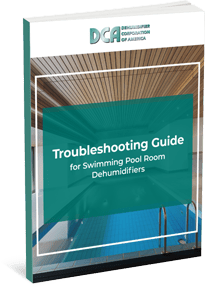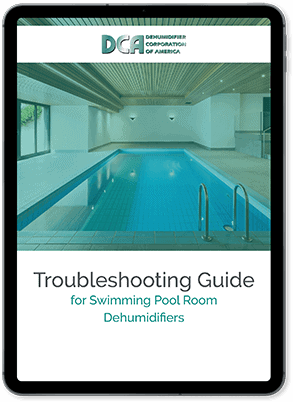Relative humidity (RH) is the percent water vapor contained in an environment’s air compared with the maximum amount of water vapor the air can contain at a specific temperature. In general as room temperature rises air can hold more moisture so the resulting RH decreases, and vice versa.
Failure to control room humidity can lead to problems with product integrity, equipment failure, costly production downtimes, and building deterioration. Industries including food processing, pharmaceuticals, printing, and indoor pool manufacturing rely heavily on good RH control to provide a healthy environment for products and personnel. Although most of these industries employ HVAC systems to regulate humidity levels, this is only a secondary function of HVAC systems. Therefore, an increasing amount of facilities are adopting dedicated dehumidification systems to achieve more precise RH levels.
Temperature Control
Building HVAC systems can supply heating, cooling and ventilation as needed. These are basic functions mostly for providing a pleasant indoor air quality environment for workers. Many facilities generate moisture in their process and/or bring in moisture laden outdoor air that needs to be addressed with dedicated dehumidification.
Because room air temperature directly affects RH, monitoring room temperature closely helps to maintain a desired RH. In general the higher the room temperature that can be maintained, without interfering with other parameters, the more moisture can be removed. Therefore, it’s important to find the highest room temperature level that works for your facility.
Humidity Control
Many industries are affected by humidity, either excessive or recessive. In many cases, a combination of a properly sized HVAC system, proper insulation and minimal air infiltration help maintain proper temperature and room RH providing an ideal year around working environment. In most cases maintaining a building RH of 50% is deemed ideal. When a particular industry demands a tightly controlled RH environment a dedicated dehumidification system is the only reliable solution.
Signs of out of control humidity can be, but not limited to, condensation forming cold surfaces such as poorly insulated walls, ceilings and slippery concrete floors. Poor product quality resulting in costly production down time, premature electric motor and electronic component failure. Also, although not immediately obvious, can be mold and mildew forming in walls and ceilings. Left unchecked, and by the time it becomes obvious, results in a total tear down and re-building may be the only solution. Irritating room inhabitants is also a result of the above explaining excessive employee absenteeism and poor production output.
Dedicated 100% outdoor air dehumidification systems remove moisture form outdoor air before it enters the building. By eliminating excessive moisture before it enters the building, the buildings HVAC system is not burdened with this nuisance. Other examples would be indoor swimming pool room situations where when pool water is maintained two to four degrees below room air temperature. This relationship results in minimizing evaporation into the space. Another example is the printing industry where, depending on location and time of the year, moisture may have to be removed or added to preserve product quality. Every industry has its own unique individual requirements and must be evaluated for a successful outcome.
Dehumidify Your Facility with Dehumidifier Corporation of America
Monitoring temperature and humidity is critical to achieving optimal internal climate conditions for your application. Dehumidifier Corp has lead the field in providing optimal dehumidification systems for over 40 years. We have the infrastructure and experience to solve your moisture problems, and we’ll custom design dehumidification systems specifically for your facility.
See how DCA helped a ceramic casting plant overcome its humidity challenges in Ensenada, Mexico, or contact us to discover solutions that give you complete control over your facility’s RH and dew point.
Topics: Humidity, Dehumidifiers





